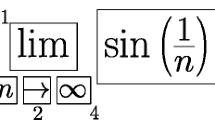Abstract
This study explored students’ understanding of a logical structure in defining the limit of a sequence, focusing on the relationship between ε and N. The subjects of this study were college students who had already encountered the concept of limit but did not have any experience with rigorous proofs using the ε–N definition. This study suggested two statements, each of which is written by using a relationship between ε and N, similar to the ε–N definition. By analyzing the students’ responses to the validity of the statements as definitions of the limit of a sequence, students’ understanding of such a relationship was classified into five major categories. This paper discusses some essential components that students must conceptualize in order properly to understand the relationship between ε and N in defining the limit of a sequence.





Similar content being viewed by others
References
Alcock, L., & Simpson, A. (2005). Convergence of sequences and series 2: Interactions between nonvisual reasoning and the learner’s beliefs about their role. Educational Studies in Mathematics, 58, 77–100.
Apostol, T. (1974). Mathematical analysis. Reading: Addison-Wesley.
Burn, B. (2005). The vice: Some historically inspired and proof-generated steps to limits of sequences. Educational Studies in Mathematics, 60, 269–295.
Cornu, B. (1991). Limits. In D. Tall (Ed.), Advanced mathematical thinking (pp. 153–166). Dordrecht: Kluwer.
Cottrill, J., Dubinsky, E., Nicolas, D., Schwingendorf, K., Thomas, K., & Vidakovic, D. (1996). Understanding of the limit concept: Beginning with a coordinated process schema. Journal of Mathematical Behavior, 16, 167–192.
Davis, R., & Vinner, S. (1986). The notion of limit: Some seemingly unavoidable misconception stages. Journal of Mathematical Behavior, 5, 281–303.
Dubinksky, E. (1988). On learning quantification. Journal of Computers in Mathematics and Science Teaching, 16, 335–362.
Dubinsky, E., Elterman, F., & Gong, C. (1988). The student’s construction of quantification. For the Learning of Mathematics, 8, 44–51.
Durand-Guerrier, V., & Arsac, G. (2005). An epistemological and didactic study of a specific calculus reasoning rule. Educational Studies in Mathematics, 60, 149–172.
Edwards, B. (1997). Undergraduate mathematics majors’ understanding and use of formal definitions in real analysis. Unpublished doctoral dissertation, The Pennsylvania State University.
Epp, S. (2003). The role of logic in teaching proof. The American Mathematical Monthly, 110, 886–899.
Gaughan, E. (1997). Introduction to analysis. Pacific Grove: Brooks/Cole.
Lincoln, Y., & Guba, E. (1985). Naturalistic inquiry. Newbury Park: Sage.
Mamona-Downs, J. (2001). Letting the intuitive bear on the formal: A didactical approach for the understanding of the limit of a sequence. Educational Studies in Mathematics, 48, 259–288.
Navarro, M., & Carreras, P. (2006). Constructing a concept image of convergence of sequences in the van Hiele framework. In A. Selden, F. Hitt & G. Harel (Eds.), Research in collegiate mathematics education (Vol. VI, pp. 61–98). Providence: American Mathematical Society.
Neuhauser, C. (2004). Calculus for biology and medicine (2nd ed.). Upper Saddle River: Pearson.
Pinto, M., & Tall, D. (2002). Building formal mathematics on visual imagery: A case study and a theory. For the Learning of Mathematics, 22, 2–10.
Przenioslo, M. (2004). Images of the limit of function formed in the course of mathematical studies at the university. Educational Studies in Mathematics, 55, 103–132.
Roh, K. (2005). College students’ intuitive understanding of the concept of limit and their level of reverse thinking. Unpublished doctoral dissertation, The Ohio State University.
Roh, K. (2008). Students’ images and their understanding of definitions of the limit of a sequence. Educational Studies in Mathematics, 69, 217–233.
Rudin, W. (1976). Principles of mathematical analysis. New York: McGraw-Hill.
Selden, J., & Selden, A. (1995). Unpacking the logic of mathematical statements. Educational Studies in Mathematics, 29, 123–151.
Strauss, A., & Corbin, J. (1998). Basics of qualitative research: Techniques and procedures for developing grounded theory. Thousand Oaks: Sage.
Stewart, J. (2003). Calculus: Early transcendental single variable (5th ed.). Belmont: Brooks/Cole-Thomas.
Taback, S. (1975). The child’s concept of limit. In M. F. Rosskopf (Ed.), Children’s mathematical concepts (pp. 111–144). New York: Teachers College Press.
Tall, D., & Schwarzenberger, R. (1978). Conflicts in the learning of real numbers and limits. Mathematics Teaching, 8, 44–49.
Tall, D., & Vinner, S. (1981). Concept image and conception definition in mathematics, with particular reference to limits and continuity. Educational Studies in Mathematics, 12, 151–169.
Williams, S. (1991). Models of limit held by college calculus students. Journal for Research in Mathematics Education, 22, 219–236.
Author information
Authors and Affiliations
Corresponding author
Rights and permissions
About this article
Cite this article
Roh, K.H. An empirical study of students’ understanding of a logical structure in the definition of limit via the ε-strip activity. Educ Stud Math 73, 263–279 (2010). https://doi.org/10.1007/s10649-009-9210-4
Received:
Accepted:
Published:
Issue Date:
DOI: https://doi.org/10.1007/s10649-009-9210-4




